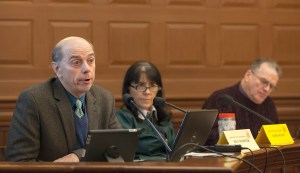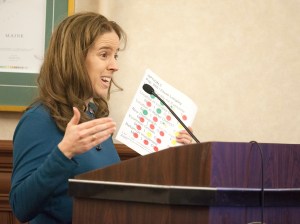LEWISTON — Six people said Lewiston should build large. Two disagreed, saying Longley and Martel schools should not be combined, and one asked that the underlying costs of a new school be revealed before taxpayers decide.
Wednesday night the public was invited to offer input on what kind of school should replace Martel Elementary before the Lewiston Redistricting Committee gives its recommendation on Feb. 2.
So far, the committee has narrowed the choices to three:
* Option B, an 860-student school that would combine Martel and Longley, giving it an 31.8 percent English Language Learner student population;
* Option C, an 950-student school that would combine Martel and Longley, relieve overcrowding at other schools and create a 31.2 percent ELL population;
* Option F, a 600-student school to replace Martel and create a 15 percent ELL population. That would relieve overcrowding at other schools but leave Longley on it’s own. Most of Longley’s students, 57.8 percent, are English Language Learners.
The state will pay for 100 percent of the new school, even if it’s a large school. But if Longley is not included in the project, Longley would have to go without renovations unless Lewiston taxpayers picked up the $7 million to $11 million bill.
Mohamed Hassan said he has two students in Lewiston schools who do not go to Longley because he wants his children to experience diversity, “to learn from students who are not from Somalia.” Most of Longley’s students are from Somali families. He said children should be in a school community “where they can learn and share from each other.”
Martel parent Shari Cloutier said the committee seems poised to recommend Option C, or the large school. That would create a school where 82.8 percent of students qualify for free or reduced lunch, a bit higher than the city’s average of 72.6 percent.
“Everything I have been reading says that higher poverty populations are best served by small, neighborhood schools,” Cloutier said. “Solving the problems of Longley students cannot happen by putting them into a 950-student school.”
Some parents may pull their students out of Lewiston public schools rather than attend such a school, she said. “Each child leaving for better opportunities takes with them some $6,000 of state money.” She encouraged committee members to favor Option F, which would leave Longley out of a new school.
“In Option F, we can chip away at facility issues at Longley over time, just like we did at McMahon over a six-year period.” And, she added, that would leave Martel’s demographics similar to what they are now.
Martel parent Stacey Smith cited higher faculty and transportation costs with a larger school. It would be better for the Longley community “if they had a school downtown because they don’t have the transportation ability that everybody else does,” she said.
Diane Wigant, who teaches fourth grade at Longley, said she supports Option C, saying “when moving forward, please don’t leave Longley students behind.”
For years, her fourth-graders attended class in a portable trailer until their numbers grew to 28, too many for the space. A new classroom was created from a hall inside the building. It seemed like a good idea at first, she said, but it’s impossible to regulate the heat.
On fall days, it’s too warm. On rainy days, “students are scattered around seven buckets catching water dripping from the ceiling.” As students took state assessment tests on Wednesday, “coats were adorned by most because of the frigid temperatures. Speaking as a taxpayer, it’s ludicrous to pump $11 million to renovate Longley.”
Kristen Cloutier, Mohamed Abdillahi, Darby Ray and Leigh Bagley spoke in favor of building a larger school for Martel and Longley students.
“I don’t think there’s a choice but to build a school that will accommodate everybody,” Cloutier said. And the school would be paid 100 percent by the state. “I’m not sure we can turn our backs on that.”
Bagley said it’s time that every child in Lewiston “had an equal opportunity to have an education. The schools we’re discussing have been below par, not in their teachers or administration, but in their facilities. They do not meet the needs of the children. They are compromised beyond repair when you compare them with Geiger and Farwell.”
Abdillahi, who works as a case manager at Longley, said the difference between Geiger and Longley “is night and day.”
Ray said Option C would solve the city’s problem and every student should have the opportunity to flourish in a enriching learning environment.
Jacquelyn Smith didn’t speak in favor of any option, but asked that taxpayers be made aware of underlying costs of a new school. A larger school would mean more teachers, more ed techs and higher transportation costs, she said, adding that would impact future school budgets.
“As a senior citizen on a limited budget, I’d like to know how that’s going to affect us.”
Superintendent Bill Webster acknowledged she was correct, if Lewiston had more space he’d ask to hire more teachers to create smaller classrooms. “That’s a fair question, one we should do our best to address,” he said.
Proposed large school just got smaller
LEWISTON — Lewiston school officials have discussed building a new elementary school that would hold between 1,100 and 1,200 students, which would make it the largest elementary school in Maine.
But on Tuesday, Superintendent Bill Webster said that a large elementary school — one that would combine Longley and Martel and reduce overcrowding throughout the city — would be a 950-student school.
The reason: He made a mistake in projecting enrollment, double counting some of the shortfall of classroom space needed for smaller classrooms. “I apologize for this,” Webster said. He’s corrected the error in updates given to the public Tuesday and Wednesday.


Comments are no longer available on this story